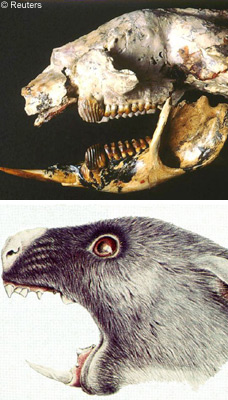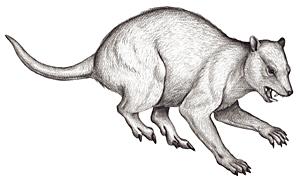1934’s Murderous Monster Marsupial
Posted by: Loren Coleman on July 15th, 2006
Sometimes the strangest things you hear about in cryptozoology catch up with physical evidence years later. Take, for instance, Killer Kangaroos. No, I’m not talking about the Mystery Kangaroos that punched out the Chicago police in the 1970s. I’m thinking, instead, about the Killer Kangaroo of 1934.

This week saw news out of Australia that “killer kangaroos,” “demon ducks of doom,” and eighteen other previously unknown species had been discovered by paleontologists at a dig site in Queensland, northern Australia.
The new animals’ tags immediately made me think of the names I’d coined or heard before in cryptozoology. Who couldn’t love the “demon ducks of doom.” Obviously, someone in Australia is showing a love of the “d” sounds of alliteration for that one, just like I did when I gave the moniker to the “Dover Demon,” which was sighted in 1977, in Massachusetts.
Paleontologist Sue Hand reported that during the dig that they found some very big birds — more like ducks — to which they gave the name “demon ducks of doom.” She said some may have been carnivorous. Obviously.
In those same Riversleigh fossil fields, the University of New South Wales team was also uncovering evidence of a “killer kangaroo,” a flesh-eating marsupial, from 10 to 20 million years ago.

Professor Mike Archer said that among the new species discovered “were meat-eating kangaroos with long fangs and galloping kangaroos with long forearms, which could not hop.”
This, needless to say, reminded me of the cryptid Killer Kangaroo of 1934, which I had researched in old newspaper archives some 30 years previous.
As I wrote in Mysterious America, reports of giant kangaroos are nothing new to cryptozoology. Over seven decades ago, the notorious “Killer Kangaroo” of South Pittsburg, Tennessee, even made it all the way to the pages of New York’s daily newspapers.
During mid-January of 1934, a huge nasty kangaroo spread terror among the Tennessee hill farmers. This extremely atypical kangaroo was reported to have killed and partially devoured several German police dogs, geese, and ducks.
The Reverend W. J. Hancock saw the animal and described it as fast as lightning, and looking like a giant kangaroo as it ran and leapt across a field. Another witness, Frank Cobb quickly came upon more evidence of the kangaroo’s activities. The head and shoulders of a large German shepherd or Alsatian were all that remained. A search party tracked the kangaroo to a mountainside cave, where the prints disappeared.
In recent years, local rival newspaper writers have tried to blame this Tennessee Killer Kangaroo story on the pen of the late Horace N. Minnis, a South Pittsburg correspondent of the Chattanooga Times. The only trouble with this “newspaper hoax” theory is that Minnis was not a newspaper correspondent for the area in 1934.
About Loren Coleman
Loren Coleman is one of the world’s leading cryptozoologists, some say “the” leading living cryptozoologist. Certainly, he is acknowledged as the current living American researcher and writer who has most popularized cryptozoology in the late 20th and early 21st centuries.
Starting his fieldwork and investigations in 1960, after traveling and trekking extensively in pursuit of cryptozoological mysteries, Coleman began writing to share his experiences in 1969. An honorary member of Ivan T. Sanderson’s Society for the Investigation of the Unexplained in the 1970s, Coleman has been bestowed with similar honorary memberships of the North Idaho College Cryptozoology Club in 1983, and in subsequent years, that of the British Columbia Scientific Cryptozoology Club, CryptoSafari International, and other international organizations. He was also a Life Member and Benefactor of the International Society of Cryptozoology (now-defunct).
Loren Coleman’s daily blog, as a member of the Cryptomundo Team, served as an ongoing avenue of communication for the ever-growing body of cryptozoo news from 2005 through 2013. He returned as an infrequent contributor beginning Halloween week of 2015.
Coleman is the founder in 2003, and current director of the International Cryptozoology Museum in Portland, Maine.










I’m new to cryptomundo, but I decided to log on for the first time yesterday.
I’ve heard of this story of the Killer Kangaroo. I think they might possibly still exist. Why not? People are still seeing strange animals.
Finding alive a Killer Kangaroo now would be a great find.
Interesting,that’s one I haven’t heared yet.I live in Tennessee and have heard alot about weird animals mostly mountain lions,panthers,and unknown big creatures rustling through woods.A whole lot of the land down here has not been explored.Alot of caves to.
I love how the fossilized remains of any unknown creature is millions of years old. Did they talk to the aboriginees about this? They have been there for thousands and if they knew about them then let’s say thousands instead. Man look at the chopper on that thing!
Demon Ducks Of Doom wonder how long before their is a sports team with that name. The fact that we are still finding unkowns even fossil form I think is outstanding. Makes one wonder what is still out their alive today!! Come on Big Fellow show yourself.
Except for being out of place, the 1934 killer kangaroo doesn’t sound so atypical. I recall as a kid on a country property our neighbour put two 303 shots into the chest of a large (over 6 foot) Eastern Grey Kangaroo then sent four pig dogs in for the kill.
He managed to save one dog by calling it back before it lunged for the roo‘s throat in the manner the previous three dogs had.
The roo’s defence against the dogs is to balance on its tail and lash out with its feet; these come on the end of enormous muscular legs and equipped with a large claw, thus the first three dogs were gutted clean down the middle, kicked to the ground like rag dolls.
Despite taking two shots, the roo then hopped off out of sight.
A word of warning if you’re visiting the roos at the zoo – keep far enough away to avoid being kicked! Even a three or four foot roo can do you damage.
I live in Scotland, no Killer ‘roos here, but plenty of escaped wallabies, the odd big cat and of course, Nessie.
I can’t help but think of el Chupacabra. There were plenty of marsupials in South America before north american cats got down there. opossums survived, a killer kangaroo-like animal wouldn’t be -impossible-.
PS – the scary thing is that red roos are bigger!
In my opinion, the artist’s drawing doesn’t match the Reuters photo. The teeth in the photo don’t look like the teeth of a carnivore … or am I way off here? The long sabre was obviously used to fend off rivals or as defense (or both) but I’m not seeing the canines depicted in the drawing.
How does this case match up with other “mystery ‘roo” cases that share characteristics with “giant monkey” cases (like the “dog” face and the hopping lope?)